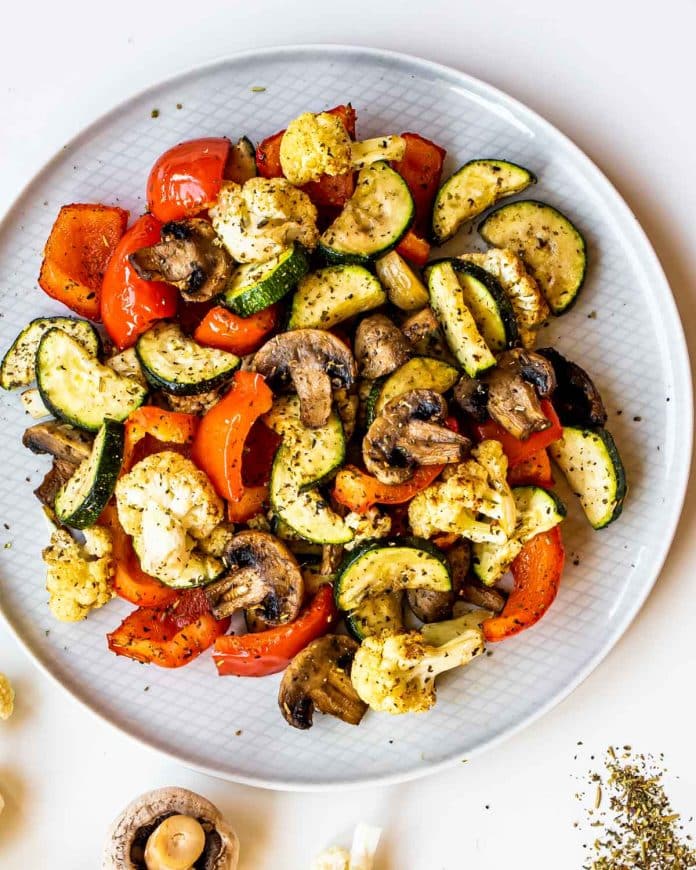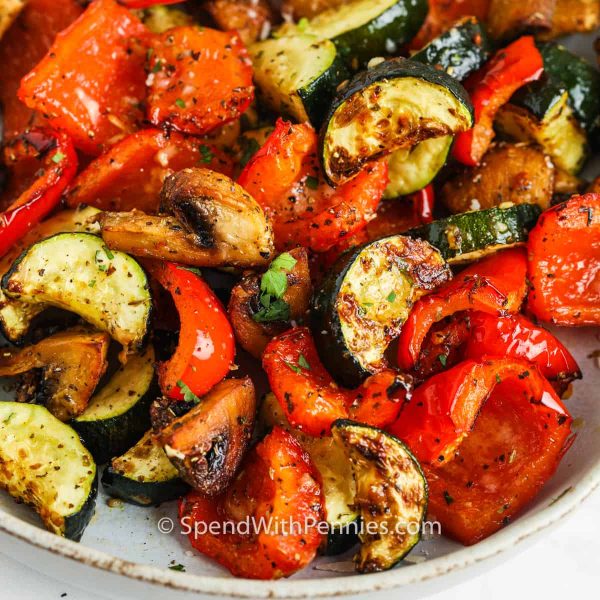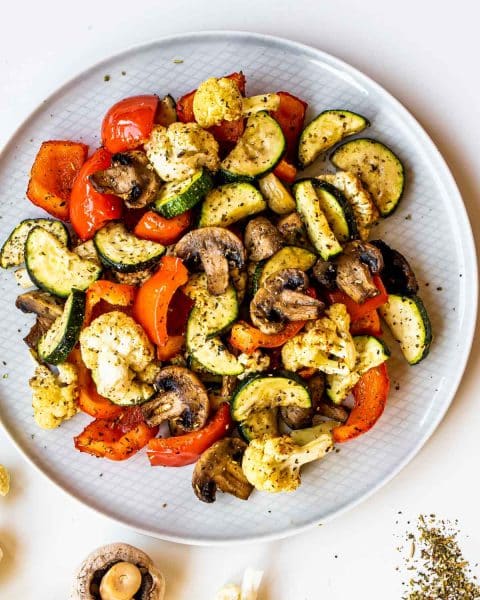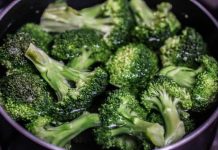If you’ve ever wondered whether you can achieve crispy and delicious vegetables using an air fryer, you’re not alone!
As the popularity of air fryers continues to soar, many home cooks are curious about the versatility of this kitchen appliance and how it can revolutionize their veggie game.
In this article, we’ll explore the exciting world of cooking vegetables in an air fryer, uncovering the benefits, providing tips and tricks for success, and revealing some mouthwatering recipes that will make you fall in love with this cooking method.
Say goodbye to soggy and lackluster vegetables, and get ready to embark on a flavorful and healthy culinary adventure with your trusty air fryer by your side!
This image is the property of www.spendwithpennies.com.
Benefits of cooking vegetables in an air fryer
Retains nutrients
When cooking vegetables in an air fryer, high-speed hot air circulation helps retain the natural nutrients in the vegetables. Unlike methods such as boiling or steaming, where nutrients can leach into the cooking water, air frying preserves the integrity of vitamins, minerals, and antioxidants in the vegetables. This means you can enjoy a nutritious and healthy meal without compromising taste.
Cooks vegetables quickly
One of the significant advantages of using an air fryer is its ability to cook vegetables quickly. The hot air circulation in the air fryer ensures that the vegetables are evenly cooked, reducing cooking time. This can be particularly useful when you’re short on time or want to prepare a quick meal for yourself or your family. Air frying vegetables allows you to enjoy delicious, perfectly cooked veggies in a fraction of the time it takes to cook them using traditional methods.
Requires less oil
Cooking vegetables in an air fryer requires significantly less oil than traditional methods, such as deep frying. The hot circulating air in the air fryer crisps the vegetables, giving them a satisfying crunch without excessive oil. This reduces the dish’s calorie content and makes it a healthier option for those watching their fat intake. Air-frying vegetables with minimal oil allow you to enjoy guilt-free, flavorful dishes without compromising taste or texture.
Enhances flavors
Air-frying vegetables enhance their natural flavors, making a delicious and satisfying dish. The circulating hot air in the air fryer creates a crisp exterior while retaining the juicy and tender interior of the vegetables. This caramelization process brings out the sweetness and natural flavors of the vegetables, making them more enjoyable to eat. Whether you’re air-frying root vegetables, leafy greens, or cruciferous vegetables, you can expect a burst of flavor with each bite.
Types of vegetables that can be cooked in an air fryer
Root vegetables
Root vegetables such as potatoes, carrots, and beets are perfect for air frying. These vegetables have a high starch content, which makes them extra crispy when cooked in an air fryer. Whether you’re making crispy French fries, roasted sweet potatoes, or garlic parmesan roasted carrots, air frying brings out the natural sweetness and texture of root vegetables.
Leafy greens
Contrary to popular belief, leafy greens can also be cooked in an air fryer. Vegetables like kale, spinach, and Brussels sprouts can be transformed into crispy, flavorful chips or as a side dish. Coat the greens in oil and season them with your favorite spices before air frying. The result is a crunchy and nutritious snack or a light and healthy accompaniment to your main meal.
Cruciferous vegetables
Cruciferous vegetables like broccoli, cauliflower, and cabbage are excellent choices for air frying. When cooked in the air fryer, these vegetables retain their crunch and take on a delicious roasted flavor. Whether making crispy cauliflower bites, roasted broccoli florets, or cabbage steaks, air frying intensifies the flavors and elevates these vegetables to a new level.
Nightshade vegetables
Nightshade vegetables, including tomatoes, peppers, and eggplants, can also be cooked in an air fryer. Air frying brings out the sweetness of tomatoes, gives peppers a smoky flavor, and turns eggplants into a rich and creamy delight. From roasted bell peppers to eggplant Parmesan, air frying allows you to enjoy the unique textures and flavors of nightshade vegetables more healthily.
Squash and pumpkin
Squash and pumpkin varieties such as butternut squash, acorn squash, and pumpkin can be perfectly cooked in an air fryer. Air frying these vegetables intensifies their natural sweetness, bringing out their tender and creamy texture. Whether you’re making crispy butternut squash fries or roasted pumpkin wedges, air frying enhances the flavors of these seasonal favorites.
Onions and garlic
Onions and garlic are staple ingredients in many dishes and can also be cooked in an air fryer. Air frying onions caramelizes them, bringing out their natural sweetness and adding a depth of flavor to your recipes.
Garlic cloves can be air-fried until they turn golden brown and become soft and spreadable. Air frying onions and garlic releases their aromatic qualities and enhances the overall taste of your dishes.
This image is the property of www.thedinnerbite.com.
Preparing vegetables for air frying
Wash and dry vegetables.
Before air frying vegetables, washing them thoroughly to remove any dirt or debris is essential. Rinse them under cold water and gently scrub them if necessary. After washing, dry the vegetables thoroughly using a clean kitchen towel or paper towel. Excess moisture can interfere with the crisping process in the air fryer, so ensure the vegetables are dehydrated before proceeding.
Cut vegetables into even pieces.
To ensure even cooking, cutting the vegetables into uniform pieces is advisable. This will help to ensure that all the pieces cook at the same rate, preventing some pieces from becoming overcooked or burnt while others are still undercooked. Depending on the vegetable, you can cut them into slices, wedges, chunks, or cubes. Aim for consistent thickness and size, resulting in evenly cooked and delicious vegetables.
Toss vegetables in oil and seasonings.
Coating the vegetables in oil will help them crisp up nicely in the air fryer. Use a small amount of oil, such as olive oil or avocado oil, and toss the vegetables well to ensure they are evenly coated.
Additionally, season the vegetables with your preferred herbs, spices, or seasoning blends to enhance their flavor. Whether you prefer simple salt and pepper or a more elaborate seasoning mix, adding your favorite seasonings will elevate the taste of your air-fried vegetables.
Preheat the air fryer.
Preheating the air fryer is essential for optimal results, like any cooking method. Preheating allows the air fryer to reach the desired temperature before adding the vegetables, ensuring they start cooking immediately. It also helps create a crispy exterior and speeds up the cooking time. Check the manufacturer’s instructions for preheating time and temperature recommendations for your specific air fryer model.
Cooking vegetables in an air fryer
Select the appropriate temperature.
Different vegetables require different cooking temperatures in the air fryer. Generally, most vegetables can be cooked at a temperature range of 350°F (175°C) to 400°F (200°C). However, denser vegetables like potatoes may benefit from a slightly higher temperature, while more delicate vegetables like leafy greens may be better cooked at a lower temperature. Refer to specific recipes or cooking guides for recommended temperatures for different vegetables.
Arrange vegetables in a single layer.
To ensure the vegetables cook evenly and become crispy, arranging them in a single layer in the air fryer basket is essential. Overlapping or crowding the vegetables can result in uneven cooking and a less crispy texture. If you have a large batch of vegetables to air fry, it is recommended to do it in multiple batches rather than overcrowding the basket. Take your time and give each vegetable ample space to ensure the best possible results.
Shake or flip vegetables halfway through cooking.
Shaking or flipping the vegetables halfway through the cooking time is essential to ensure even cooking and prevent sticking. This will help the vegetables cook evenly on all sides, resulting in a uniform texture and flavor. Use a pair of tongs or a spatula to gently toss or flip the vegetables, taking care not to break them apart. This step is particularly crucial for vegetables prone to sticking or irregular shapes.
Adjust cooking time based on vegetable type and desired doneness.
The cooking time for vegetables in an air fryer can vary depending on the vegetable type, size of the pieces, and desired level of doneness.
While most vegetables take 10 to 15 minutes to cook, keeping an eye on them and adjusting the cooking time as needed is essential. Check the vegetables periodically to determine their doneness, and ensure they are cooked to your preferred level of crispness or tenderness.
This image is the property of www.recipevibes.com.
Tips for cooking vegetables in an air fryer
Do not overcrowd the air fryer basket
As mentioned, overcrowding the air fryer basket can lead to uneven cooking and a less crispy texture. To ensure the best results, give each vegetable ample space in the basket, allowing the hot air to circulate freely. If you have a large batch of vegetables, cooking them in multiple batches is better than overcrowding the basket.
Avoid using too much oil.
While a small amount of oil is necessary to achieve a crispy texture, it is essential not to use an excessive amount. Remember that air frying relies on hot circulating air rather than oil for cooking. Too much oil can make the vegetables greasy and add unnecessary calories. Aim for a light oil coating to ensure the vegetables crisp up nicely without becoming oily.
Experiment with different seasonings and spices
Air-frying vegetables provide an excellent opportunity to experiment with different seasonings and spices. Whether you prefer classic combinations like garlic and rosemary or more adventurous flavors like curry or Cajun seasoning, feel free to get creative with your seasonings. Try different combinations to find your favorite flavors and enhance the taste of your air-fried vegetables.
Use a food thermometer to ensure vegetables are cooked through
While air-frying vegetables is quick and efficient, ensuring they are cooked through is still essential. To confirm doneness, you can use a food thermometer to check the internal temperature of the vegetables. The specific temperature will depend on the vegetable type, but a general guideline is around 165°F (74°C) for most vegetables. This will ensure that the vegetables are cooked to a safe internal temperature and are tender and flavorful.
Common mistakes when cooking vegetables in an air fryer
Using wet vegetables
Starting with wet vegetables can hinder the crisping process in the air fryer. Thoroughly dry the vegetables before cooking them to prevent soggy results. This step is crucial when air frying vegetables that naturally contain more moisture, such as tomatoes or zucchini.
It is not preheating the air fryer.
Preheating the air fryer is crucial for achieving optimal results. Failing to preheat the air fryer can result in longer cooking times and less desirable textures. Allow the air fryer to reach the desired temperature before adding the vegetables for the best cooking experience.
Cooking at too high a temperature
While air frying is known for its ability to cook food quickly, excessively high temperatures can lead to overcooking and burning vegetables. It is essential to follow the recommended temperature guidelines for each vegetable to ensure even cooking and avoid any unpleasant outcomes.
Forgetting to shake or flip the vegetables
Shaking or flipping the vegetables halfway through the cooking process is essential for even cooking. Forgetting this step can result in unevenly cooked vegetables or pieces sticking to the air fryer basket. Be mindful of the cooking time, and gently toss or flip the vegetables for a uniform texture and flavor.
Overcrowding the air fryer basket
Overcrowding the air fryer basket can prevent the hot air from circulating evenly, leading to uneven cooking. It is essential to arrange the vegetables in a single layer, allowing ample space for the hot air to circulate each piece. Cook in multiple batches if necessary to maintain the high-quality results air frying is known for.
This image is the property of cravinghomecooked.com.
Alternative ways to cook vegetables
Roasting in the oven
If you don’t have an air fryer or prefer a different cooking method, roasting vegetables in the oven is an excellent alternative. Preheat the oven to the recommended temperature, toss the vegetables in oil and seasonings, and spread them out in a single layer on a baking sheet. Roast the vegetables according to their specific cooking times, flipping them halfway through until they are tender and caramelized.
Steaming on the stovetop
Steaming vegetables on the stovetop is a healthy and quick way to cook them. Fill a pot with a small amount of water, place a steamer basket or colander on top, and bring the water to a boil. Add the vegetables to the steamer basket, cover the pot, and steam until the vegetables are tender yet still vibrant in color. Steaming preserves the nutrients and natural flavors of the vegetables while keeping them moist and tender.
Grilling on a barbecue
Grilling vegetables on a barbecue adds an irresistible smoky and charred flavor. Preheat the barbecue to medium-high heat, brush the vegetables with oil and seasonings, and place them directly on the grill. Cook the vegetables until they are tender and have grill marks, flipping them occasionally to ensure even cooking. Grilled vegetables make a delicious and healthy side dish or a flavorful addition to salads and sandwiches.
Boiling or blanching
Boiling or blanching vegetables is a quick and easy method suitable for certain vegetables, such as green beans or asparagus. Bring a pot of water to a boil, add the vegetables, and cook them until they are tender yet slightly crisp. Immediately transfer the vegetables to an ice bath to stop cooking and preserve their vibrant color and nutrients. Boiled or blanched vegetables can be enjoyed as standalone side dishes, added to salads, or used in stir-fries.
Stir-frying in a pan
Stir-frying vegetables in a pan on the stovetop is a popular cooking method in many cuisines. Heat a small amount of oil in a wok or large skillet, add the vegetables, and stir-fry them over high heat until they are cooked to your desired tenderness. The high heat and quick cooking time preserve the texture and flavors of the vegetables while imparting a delicious smoky wok flavor. Serve stir-fried vegetables as a side dish or use them as a base for stir-fries, noodles, or fried rice.
Comparing air frying with other cooking methods
Health benefits
Compared to deep frying, air frying vegetables significantly reduces the amount of oil used in cooking. This, in turn, lowers the dish’s calorie content and fat intake. Air frying also retains more nutrients than boiling or steaming, making it a healthier option for cooking vegetables. Roasting, grilling, and stir-frying are also healthy cooking methods that can preserve the nutritional value of vegetables while adding delicious flavors.
Cooking time
Air frying vegetables is known for its quick cooking time. The hot circulating air in the air fryer speeds up the cooking process, allowing you to enjoy perfectly cooked vegetables in less time. Roasting vegetables in the oven or grilling them on a barbecue may take longer, depending on the specific vegetable and its size. Stir-frying and steaming are also relatively quick cooking methods suitable for vegetables.
Texture and flavor
Air frying vegetables produce a unique texture, with a crispy exterior and a tender interior. Roasting vegetables in the oven can produce a crispy texture with a caramelized flavor. Grilling imparts the vegetables a smoky and charred flavor, while stir-frying preserves the natural crunchiness. Steaming keeps the vegetables moist and tender while preserving their natural flavors.
Equipment needed
Air frying requires an air fryer, a countertop appliance designed explicitly for this cooking method. This may be an additional investment if you don’t already own one. Roasting vegetables in the oven requires a baking sheet or roasting pan while grilling vegetables requires a barbecue or grill. Stir-frying can be done with a wok or large skillet, and steaming requires a pot with a steamer basket or colander. The equipment needed for each cooking method may vary, so consider your kitchen setup and personal preferences when choosing a cooking method for your vegetables.
This image is the property of spicecravings.com.
Recipes for air-fried vegetables
Crispy air-fried Brussels sprouts
Ingredients:
- 1 pound Brussels sprouts
- One tablespoon of olive oil
- Salt and pepper to taste
- Optional: grated Parmesan cheese, balsamic glaze
Instructions:
- Preheat the air fryer to 400°F (200°C).
- Trim the ends of the Brussels sprouts and remove any wilted outer leaves.
- Cut the Brussels sprouts in half and place them in a large bowl.
- Drizzle the olive oil over the Brussels sprouts and toss until they are coated evenly.
- Season with salt and pepper to taste.
- Place the Brussels sprouts in a single layer in the air fryer basket.
- Air fry for 12-15 minutes, shaking the basket or flipping the sprouts halfway through until they are crispy and golden brown.
- Remove from the air fryer and serve hot.
- Optional: Sprinkle with grated Parmesan cheese or drizzle with balsamic glaze for added flavor.
Garlic parmesan zucchini fries
Ingredients:
- Two medium zucchini
- 1/2 cup breadcrumbs
- 1/4 cup grated Parmesan cheese
- One teaspoon of garlic powder
- 1/2 teaspoon paprika
- 1/4 teaspoon salt
- 1/4 teaspoon black pepper
- One large egg, beaten
Instructions:
- Preheat the air fryer to 400°F (200°C).
- Cut the zucchini into long, thin strips resembling French fries.
- Combine the breadcrumbs, Parmesan cheese, garlic powder, paprika, salt, and black pepper in a shallow bowl.
- Dip each zucchini strip into the beaten egg, allowing any excess to drip off.
- Roll the zucchini strip in the breadcrumb mixture, pressing gently to coat evenly.
- Place the coated zucchini strips in the air fryer basket in a single layer.
- Air fry for 10-12 minutes or until the zucchini strips are golden brown and crispy.
- Remove from the air fryer and serve immediately with your favorite dipping sauce.
Roasted cauliflower bites
Ingredients:
- One head cauliflower, cut into florets
- Two tablespoons of olive oil
- One teaspoon of garlic powder
- One teaspoon paprika
- 1/2 teaspoon salt
- 1/4 teaspoon black pepper
Instructions:
- Preheat the air fryer to 400°F (200°C).
- Combine the cauliflower florets, olive oil, garlic powder, paprika, salt, and black pepper in a large bowl.
- Toss the cauliflower florets until they are evenly coated with the oil and spices.
- Place the cauliflower florets in a single layer in the air fryer basket.
- Air fry for 15-18 minutes, shaking the basket or flipping the florets halfway through, until the cauliflower is tender and golden brown.
- Remove from the air fryer and serve as a delicious side dish or a healthy snack.
Spicy sweet potato wedges
Ingredients:
- Two large sweet potatoes
- Two tablespoons of olive oil
- One teaspoon of chili powder
- 1/2 teaspoon paprika
- 1/2 teaspoon garlic powder
- 1/2 teaspoon salt
- 1/4 teaspoon black pepper
Instructions:
- Preheat the air fryer to 400°F (200°C).
- Scrub the sweet potatoes clean and cut them into wedges.
- Combine the olive oil, chili powder, paprika, garlic powder, salt, and black pepper in a large bowl.
- Toss the sweet potato wedges in the spice mixture until they are evenly coated.
- Place the sweet potato wedges in the air fryer basket in a single layer.
- Air fry for 18-20 minutes, shaking the basket or flipping the wedges halfway through, until the sweet potatoes are tender and crispy.
- Remove from the air fryer and serve hot as a tasty side dish or a satisfying snack.
Conclusion
Cooking vegetables in an air fryer offers numerous benefits, including the retention of nutrients, quick cooking times, the use of less oil, and enhanced flavors. From root vegetables to leafy greens and everything in between, a wide variety of vegetables can be cooked perfectly in an air fryer.
Following proper preparation techniques and cooking instructions and avoiding common mistakes, you can enjoy deliciously crispy and healthy vegetable dishes in no time. Whether you choose air frying, roasting, grilling, steaming, boiling, or stir-frying, it’s all about finding the method that suits your taste preferences and dietary needs.
So, grab your favorite vegetables, dust off your air fryer, and start exploring the wonderful world of vegetable cooking possibilities.









































